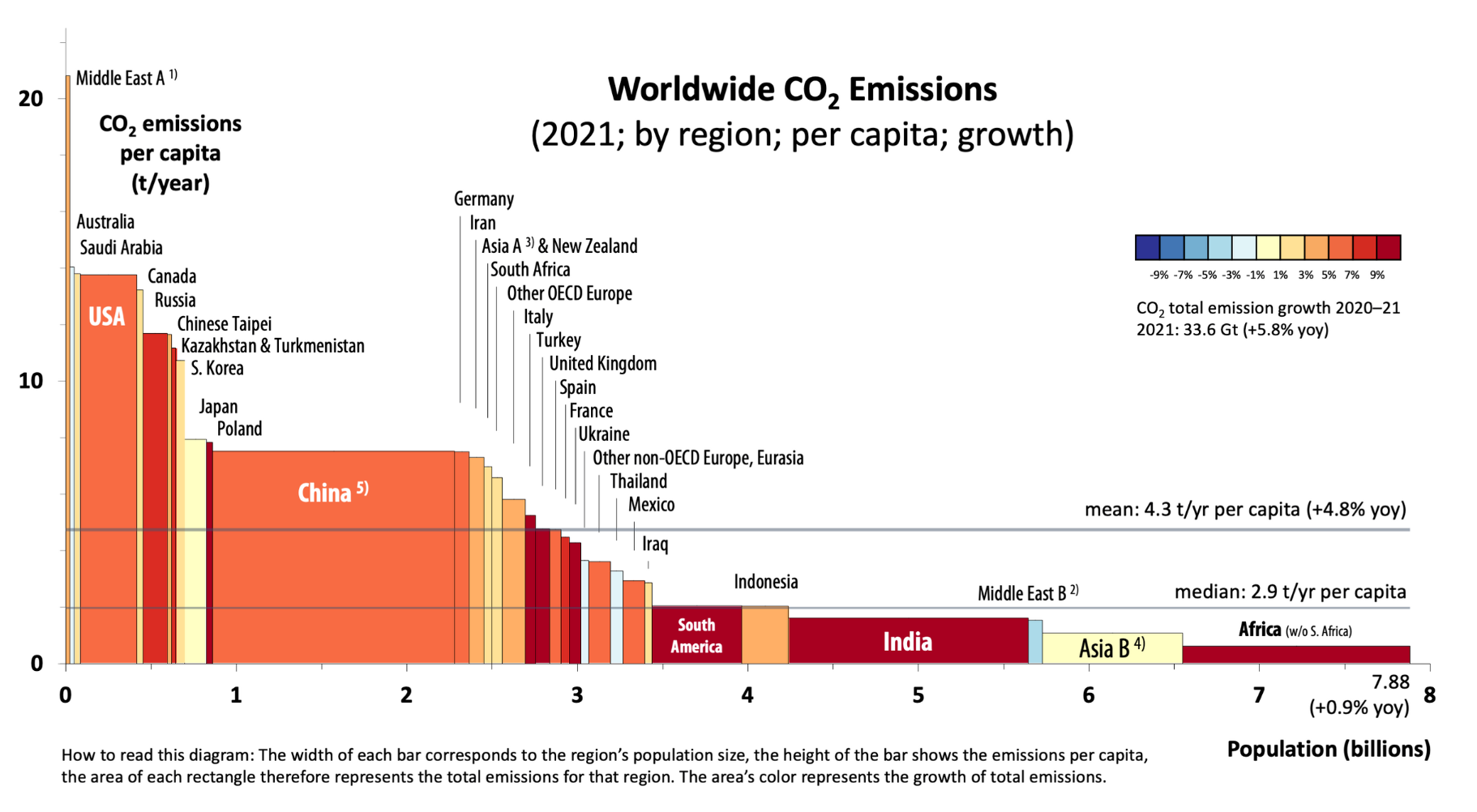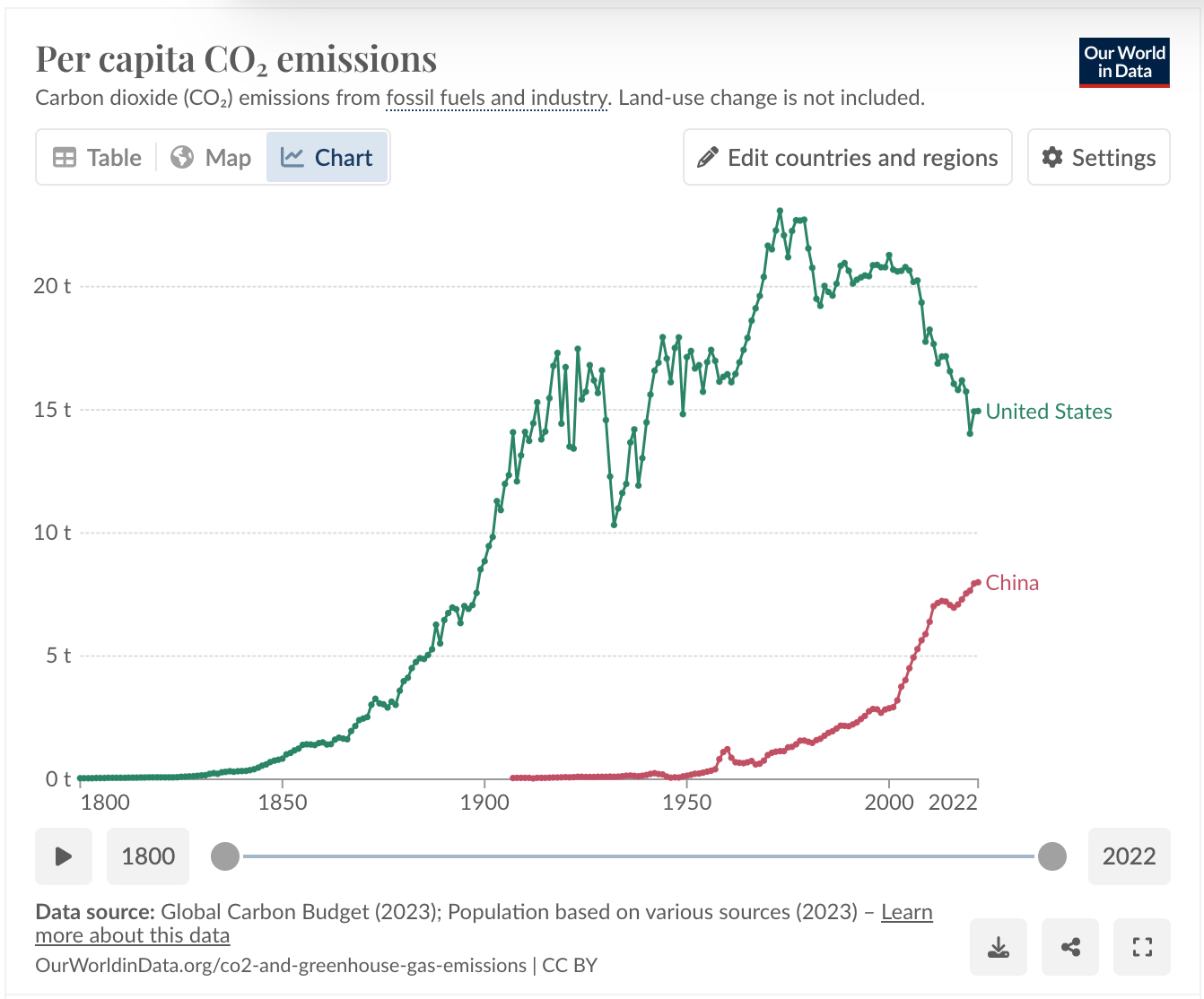Imperial Hypocrisy of the US-China Climate Talks

Image by Getty and Unsplash+.
Earlier this month, US climate envoy John Podesta met with Chinese Foreign Minister Wang Yi in Beijing to discuss climate financing for the upcoming years. The US has long criticized China’s approach to confronting the climate threat, and continuously pushes Chinese leaders to do more.
At the same time, US leaders label China’s investment into green energy technology as “exploitative” and attempt to sabotage its efforts with high tariffs, driving up the cost of Chinese imports, and making it more challenging to make the transition to green energy.
“They get less attention but they’re fully half of what’s causing global warming,” Podesta commented.
Former President Donald Trump officially cut off climate talks with China in 2017 after withdrawing from the Paris Agreement. This past year, Biden has made increasing efforts to engage with China on the topic before the end of his term.
This month’s climate talks are underscored by Beijing’s doubt over the upcoming election and the knowledge that any agreements would be undermined by another Trump win. Foreign Minister Wang Yi has also voiced concerns over US “pan-securitism and protectionism”—
kind words for describing US actions that are accelerating a new cold war with China, including steps for conflict escalation by 2027.
Still, in the face of Washington’s increasingly threatening posture, Yi emphasizes the importance of US-China climate cooperation, saying the talks are “a positive signal to the outside world that as two major powers, China and the US not only need to cooperate but can indeed work together.”
Discussions under the Biden administration began with former climate envoy John Kerry, who stepped down earlier this year. Kerry was one of the chief negotiators of the Paris climate agreement and had built strong rapport with top Chinese officials over the years. New climate envoy John Podesta got his start in climate policy under the Obama administration, but is well known for serving as the White House chief of staff under President Bill Clinton, and for his consummate insider status in wealthy liberal circles. He co-founded the Podesta Group with his brother, which operated as one of the most powerful lobbying firms before it was shut down following its association with the Robert Mueller investigations. He’s also the founder of the progressive think tank Center for American Progress, which was created with the support of other liberal elites.
As the newest climate envoy, Podesta joins a long line of wealthy US political leaders more inclined to imperialist finger-wagging fueled by western superiority and fears that China’s rise threatens US global hegemony. So while the US pushes China to do more, it also strategically undermines its efforts.
Let’s break it down.
Is China doing “enough?”
First, it’s important to note that China’s population makes up approximately 18% of the world, and its CO2 emissions per capita fall short of many other countries, including the US, Canada, Australia, South Korea, and the UAE.

Additionally, China is a relatively new industrial power, and the total amount of CO2 emitted over the last three centuries is incomparable to the 400 billion metric tons produced by the United States since 1750. It was only in recent years that China saw a sharp growth in emissions.

China’s early 20th century was marked by a political and social struggle of internal instability after the fall of the Qing Dynasty in 1911. After the establishment of the PROC in 1949, the challenge became improving the lives of its citizens. The Chinese government has been working to increase living standards across the country, and is, in fact, the only country to rise from low to high on the UN Development Index since the program was created. Over 840 million people were taken out of extreme poverty, leading to a sharp rise in life expectancy, literacy rates, and quality of life.
In the early 2000s, as China became increasingly aware of the negative impacts of its fossil fuel use, leaders sought solutions that would create opportunities for future populations and not negate any of the progress made in the last century. Thus began China’s turn to manufacturing renewable technology in industries from solar to wind, green hydrogen, and geothermal energy. Today, China has approximately 80% of the world’s capacity for solar manufacturing. The mass production of renewable tech enabled lower sales costs, paving the way for nations in the Global South to afford making the move to green energy. In fact, China’s production of wind and solar tech enabled other nations to reduce CO2 emissions by over 800 million tons in 2023 alone.
In 2020, President Xi Jingping announced the plan for China to become carbon neutral by 2060, with a carbon peak no later than 2030. The declaration spurred new green projects and policies aimed at accomplishing the goal. The National Energy Administration (NEA), which regulates China’s energy, launched the Whole County PV program, which aims to install solar panels in half of China’s rural administration (a quarter of the population). China’s desert regions were deemed ideal locations for massive wind and solar farms, which will connect to towns and cities through high-speed transmission lines. In 2022, China installed as much solar capacity as all other nations combined, then doubled that number the following year– which was over twice as much as the United States.
It’s true that China still has a long way to go when it comes to switching away from fossil fuels, but it’s currently on track to reach its goals– and the Chinese government has a plan, which includes the construction of a unified power grid to better manage supply and demand.
So why the criticism?
Ultimately, the US and China have different strategies of approaching the climate issue, and the US isn’t happy with China’s methods. In fact, US criticism over China’s green energy strategy lay partially in its condemnation of China’s monopoly over green energy tech, and the effects affordable prices could have on other US business sectors, such as car manufacturing. Just last week, the US locked in steep tariffs of 100% on incoming EVs from China, 50% on chips, and 25% on batteries. Chinese company BYD is the biggest Electric Vehicle (EV) manufacturer, with costs as low as $10,000 per car. Though not currently operating in US markets, BYD electric cars with imposed tariffs would still be the cheapest option for US consumers.
It seems likelier that US politicians will protect the auto industry, which poured $85.5 million into lobbying efforts in 2023, a record high, rather than allow affordable, environmentally friendly electric cars from China to take over the market. Unfortunately, many politicians continue to call climate change a hoax and refer to EVs, like Trump did, as “green new scams.”
Chief economist of the International Monetary Fund, Pierre-Olivier Gourincha, commented on the matter, warning that the high tariffs will “make it harder to coordinate policies that address global challenges, such as the climate transition.” Similarly, David Victor, Professor of innovation and public policy at the University of California San Diego, wrote that these policy moves are “bad for the environment” and will only “slow down the transition.”
The US also continues to push China to contribute more money to fund countries in the Global South under the Copenhagen Accord drafted at the 2009 United Nations Climate Change Conference (COP15), in which multiple countries pledged to contribute to a $100 billion goal annually by 2020. However, while Podesta and Yi were talking about climate finance, other Chinese leaders were hosting the 2024 Summit of the Forum on China-Africa Cooperation with leaders from over 50 states across Africa. The summit concluded with China announcing an additional $50 billion in funding over the next three years, with a heavy focus on green energy transitioning. Additionally, President Xi announced plans to launch 30 new clean energy projects, as well as plans for EV manufacturing.
China’s rapid economic growth and growing global influence has enabled it to be an alternative source of investment for developing nations across the world. Western powers have been quick to criticize China’s global initiatives, brushing them off as self-interested and negatively impactfully– though only when it’s outside the bounds of western institutions like the International Monetary Fund. This is hypocritical, over-simplified, and misleading.
According to a McKinsey Global Institute report, delays in the global green energy shift will produce catastrophic results. As of right now, only 10% of the necessary low-emission technology needed to reach carbon neutrality by 2050 has been deployed. It’s crunch time, and slowing the transition due to political or economic interests is unacceptable.
Essentially, the US orders China to contribute more to countering climate change, all while treating China’s growing dominance over the “green economy” as a security threat, and labeling China’s efforts to invest in green energy projects in the Global South as “geopolitical expansionism.” The message is clear: China needs to contribute to the climate effort, but only in ways the US deems acceptable.
This strategy is ultimately counterproductive– it will only hinder the global effort to convert to renewable energy and delay climate goals, setting the stage for future potential environmental disasters. Instead, the US and China need to work together as two of the most powerful countries to pave the way to net global carbon neutrality. This means removing tariffs on green energy tech, and providing avenues for all countries to make the transition. At the same time, the US needs to make internal change, and defund the world’s highest polluting institution– the US military.
Sources:
https://www.globaltimes.cn/page/202408/1318843.shtml
https://e360.yale.edu/features/china-renewable-energy
https://ourworldindata.org/co2/country/china
https://www.bbc.com/news/articles/cy0r74j7j1wo
https://www.cnn.com/2023/03/20/world/ipcc-synthesis-report-climate-intl/index.html
No comments:
Post a Comment